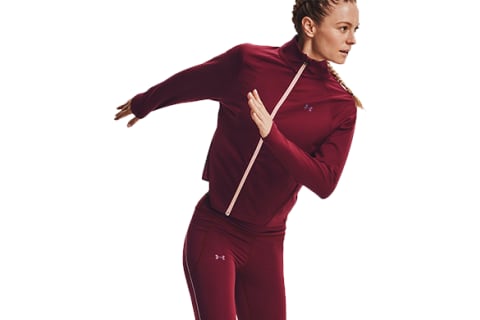Advertisement
Are You Working Out In The Cold? Then You Need These 5 Brrr-illiant Recovery Tips

When the brisk winter winds blow in, some people take that as a cue to head indoors. But for outdoorsy fitness enthusiasts, the cold itself is a reason to get outside. Cold weather has been proven to shift our body fat composition1, and training in cooler temperatures is associated with greater endurance2. In other words, there's nothing getting between us and our training goals. But progress doesn't just come from training harder. It's also about recovering smarter—every time of year.
Do you have a winter recovery routine?
If we want to take our goals across the finish line, we have to spend time training and pushing ourselves. But recovery is how we meet that finish line feeling good, in our most balanced state of health. To deepen our understanding of recovery, we asked NASM-certified personal trainer Jason Williams for his take. "Recovery is crucial to be able to perform at an optimum level," he said. "Recovery helps with muscle soreness, inflammation, sleep, stress levels, immune system, and more."
And while recovery is important 365 days a year—it actually requires a little extra attention when the clouds roll in and the thermometer drops. Just like your workout gear may need a little winterizing with the help of UA RUSH ColdGear, perhaps it's time to outfit your winter recovery routine with these five tips:
1. Gear up with recovery in mind.
Training and recovery go hand in hand. If we can optimize our training routine with recovery, and vice versa, then we can elevate our entire fitness approach. And with that in mind, how about starting the recovery process before your workout has even ended? For that, we can turn to the most high-tech fabrics on the market these days. UA RUSH Fleece, for example, reduces fatigue via mineral-infused fabric. It uses infrared technology to help you come back faster. This recycled energy increases localized circulation, meaning that you're initiating the recovery process even while you're working out... And every athlete appreciates a head start.
Get cozy in this Fleece Full-Zip Hoodie and Fleece Pants, and you'll find yourself dressed head-to-toe in gear that helps you warm up, recharge, and get ready for round two. Not only is this outfit soft and supremely comfortable, but it also works around the clock using your body's own energy to help you recover faster—like an infrared sauna on the go.
2. Hydrate with room-temperature liquids.
Hydration is recovery 101. When we're training, our body is constantly losing fluids and electrolytes as we sweat. But maintaining hydration after we train is connected to reduced fluid loss, performance, a healthier heart rate, and reduced heat stress3. Jason Williams confirmed: "We tend not to drink as much water when it is cold, but it's important to drink water as well as electrolytes to aid in recovery." To stay hydrated during colder months, keep your water or electrolyte beverages room temperature, or even slightly warm. You can also incorporate more warm and hydrating foods into your diet, like soups and broths.
3. Practice dynamic stretching.
When we think of recovery, stretching is usually top of mind. But in the wintertime, we need to be safer about how we get our stretch on. The most common type of stretching is known as static stretching4, where we hold still in position for an extended period (like a forward fold or quad stretch). But because static stretching can lead to injury when your muscles are cold, start with a quick walk or jog to get your blood flowing. Or, practice more dynamic stretching4, meaning stretching through movement, like arm circles or swinging your leg forward and back.
Stretching is a necessary ingredient to your winter recovery routine, but you need an outfit that will move with you... You need the brrr-blocking, four-way stretch of these No-Slip Waistband Leggings. Plus, training in the cold means you already have extra layers and factors to work with. This no-slip waistband makes sure that fidgeting with your leggings isn't one of them.
4. Foam roll it out.
One of Jason Williams' favorite winter recovery techniques is foam rolling because "Self myofascial release is great for recovery for muscle soreness and tightness." In fact, foam rolling may be even safer than stretching for relieving soreness from cold muscles since it doesn't require active lengthening of the muscle fibers. Studies confirm that foam rolling is a reliable technique for "enhancing joint range of motion and pre- and post-exercise muscle performance5." And who doesn't love that hurts-so-good feeling of myofascial release?
5. Treat yourself to an Epsom salt bath.
We've saved the best recovery tip for last. After braving the elements and sweating yourself closer to your goals, few things feel better than a warm bath or shower to bring chilly muscles back to life. But for Jason Williams, it's a warm bath with Epsom salt that not only helps with muscle soreness but helps to reduce stress. Research6 even shows that warming our body temperature helps "systemically relax the muscles, soften collagen in ligaments and articular capsules, and improve musculoskeletal function." Yes, this is your science-backed reason to grab some bubbles, a rubber duck, and relax.
There's no stopping you.
It doesn't matter what your training goal is—life is guaranteed to show up and challenge it... Perhaps in the form of a cold front and bitter breeze. But it's the obstacles that show us how determined we truly are. Dressed head-to-toe in Under Armour RUSH Fleece and equipped with a deeply nourishing recovery routine... There's no stopping you now.
6 Sources
- https://www.nih.gov/news-events/nih-research-matters/cool-temperature-alters-human-fat-metabolism
- https://www.ncbi.nlm.nih.gov/pmc/articles/PMC8471173/
- https://pubmed.ncbi.nlm.nih.gov/15212747/
- https://www.ncbi.nlm.nih.gov/pmc/articles/PMC3273886/
- https://www.ncbi.nlm.nih.gov/pmc/articles/PMC4637917/
- https://www.ncbi.nlm.nih.gov/pmc/articles/PMC6011066/



